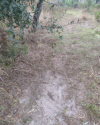Sziggy2.0
Well-Known Member
- Joined
- Apr 5, 2019
- Messages
- 883
I was scouting today in some river bottom that has seen flooding in 2012 and 2019. I have not really hunted in this type of terrain before. I usually hunt more hill country or typical Midwest farm type areas.
There are large areas that obviously had been flooded and the soils in these areas were loose sandy soils. I found over 2 dozen scrapes and a real good scrape line on area that was slightly higher and had more clay type soils. I did not find any in the sandy soils. This observation lead me to ask, why?
Does the soil matter to deer where they make scrapes. Anybody observe this as well and have more insight?
There are large areas that obviously had been flooded and the soils in these areas were loose sandy soils. I found over 2 dozen scrapes and a real good scrape line on area that was slightly higher and had more clay type soils. I did not find any in the sandy soils. This observation lead me to ask, why?
Does the soil matter to deer where they make scrapes. Anybody observe this as well and have more insight?


